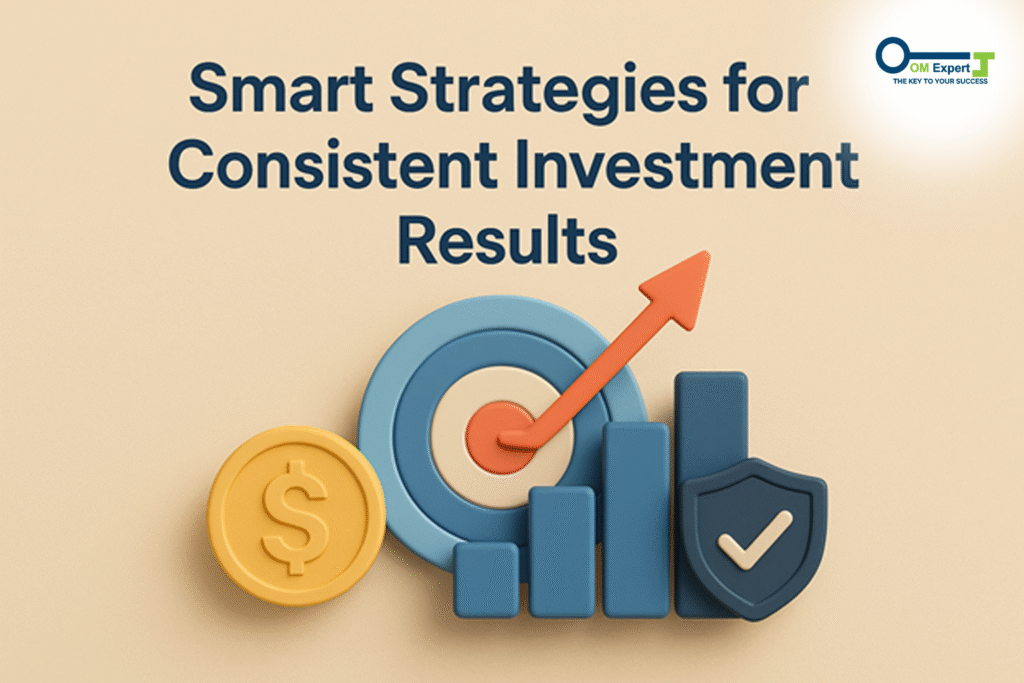Nifty 50 Trends for Retail Investors to Make Smart Investment Decisions

Stock market investing can be stressful, particularly for new investors. Knowledge, strategy, and awareness are essential for recognizing the correct opportunities, given the variety of indices, equities, and market signals. The Nifty 50 trends is a crucial benchmark for the performance of equities across all Indian indices.
In this blog, we analyze the Nifty 50 patterns to help individual investors make informed investment decisions in the current challenging market.
An Overview of Understanding the Nifty 50
It is crucial to understand the Nifty 50 and its significance before attempting any trading techniques. This index reflects the overall state of the Indian economy, as well as the performance of its strongest businesses. The first step to wise investment for retail investors is understanding the fundamentals of the Nifty 50 trends.
The top 50 businesses listed on the National Stock Exchange, ranked by their market capitalization, are represented by the Nifty 50 index. It displays the performance of larger corporations in industries such as consumer goods, banking, IT, and energy, and serves as an index for the Indian stock market.
Why Retail Investors Focus on Nifty 50
Retail investors often prefer the Nifty 50 for its stability and growth potential. It provides:
- Diversification across leading sectors.
- Lower volatility compared to mid-cap or small-cap stocks.
- Transparency in performance tracking and data availability.
For retail investors, understanding Nifty 50 trends makes it easier to identify expansion prospects and successfully mitigate risks.
Recent Nifty 50 Trends Shaping Investment Decisions

Making profitable selections requires being abreast of industry developments. Retail investors can strategically position themselves in the market by recognizing the existing and developing trends.
1. Sectoral Performance Insights
Retail investors need to monitor sectoral performance. Energy and metals exhibit cyclical characteristics, whereas industries such as IT, pharmaceuticals, and banking have demonstrated steady growth. Investors can optimize their portfolios to capitalize on sectors with strong growth by analyzing the Nifty 50 sector breakdown.
2. Market Sentiment and Technical Signals
Nifty 50 trend patterns are greatly impacted by market mood. Early indicators of possible market movements can be obtained by understanding investor behavior, news, and momentum. Investors can find Nifty 50 trends reversals, moving averages, and resistance and support levels using technical analysis of the Nifty 50. This enables retail traders to better time their inputs and exits.
3. Historical Trends and Learning from Past Data
Investors can learn how the market responds to global events, policy changes, and economic cycles by examining Nifty 50 historical trends. Investment strategies can be enhanced by combining historical knowledge with predictive algorithms, such as those used in the Nifty 50 index prediction.
Smart Investing Strategies for Retail Investors

1. Diversified Portfolio Planning
Retail investors should practice portfolio diversification to balance risk and reward. Investing across multiple sectors and stocks within the Nifty 50 ensures stability and reduces dependency on a single stock’s performance.
2. Incorporating Risk Management Investing
Risk control is essential. It is possible to minimize losses during market downturns and maximize gains during bullish periods by using limit orders, position sizing, and frequent portfolio evaluations.
3. Long-term vs. Short-term Investing
- Long-term investing Nifty 50 can help ride market volatility and achieve compounding growth.
- Intraday trading insights and short-term trading can benefit investors with a higher risk appetite, but they require careful monitoring and a well-defined strategy.
Advanced Tools for Tracking Nifty 50 Trends

Market analysis is made easier with the help of technology. Retail investors can track equities, stay informed about Nifty 50 trends, and make more informed decisions more quickly with the right tools.
- Nifty 50 analysis platforms help monitor stock movement.
- Stock market research tools offer insights into fundamental analysis, technical indicators, and news alerts.
- SurferSEO/Ahrefs-style dashboards can track stock selection strategies and market trends.
1. Fundamental Analysis of Stocks
Retail investors can identify discounted Nifty 50 companies by examining a company’s debt levels, earnings growth, P/E ratios, and dividend history. Revenue trends, ROE, and competitive advantage are important variables. A further level of understanding is provided by comprehending management quality and industry positioning.
To find growth prospects, retail investors can combine these principles with sector analysis of the Nifty 50. In general, a strong fundamental approach reduces the risk of making poor stock selections and ensures wiser, long-term investment decisions.
2. Leveraging Technical Indicators
Nifty 50 trends, patterns, and ideal entry/exit points can be found using charts, trendlines, moving averages, RSI, MACD, and candlestick patterns. Investing becomes more intelligent and disciplined when technical analysis Nifty 50 is combined with market news and risk management techniques.
Trend confirmation tools prevent rash decisions, and support and resistance levels help determine when to buy or sell. Combining technical tools with a well-defined Nifty 50 investment strategy enhances confidence in trading decisions, even for novice traders. In a volatile stock market, this strategy aids individual investors in making accurate decisions.
Retail Investor Strategies: Tips for Beginners
A clear roadmap helps beginners avoid common mistakes. Learning the basics, planning investments, and following disciplined strategies are key to early success.
- Investing for beginners: Start with Nifty 50 ETFs or index funds.
- Stock market tips: Keep emotions aside; follow market trends objectively.
- Trading strategies for beginners: Use smaller positions and stop-loss mechanisms.
- Investment planning India: Allocate funds based on risk tolerance and time horizon.
Key Indicators of Nifty 50 Performance
Monitoring the right indicators allows investors to make timely and effective decisions. By understanding market signals, one can anticipate trends before the crowd reacts.
- Nifty 50 market signals: Observe trend patterns, trading volumes, and macroeconomic cues.
- Nifty 50 growth stocks: Track companies with strong earnings growth and potential market leadership.
- Smart stock picks: Identify undervalued yet high-potential stocks using research and analysis.
Investment Techniques for Enhanced Returns
Strategic planning, discipline, and research drive higher returns. Retail investors who combine these elements see sustained portfolio growth.
1. Portfolio Optimization Nifty 50
Investors should aim for portfolio optimization of the Nifty 50 by balancing high-growth and stable stocks, minimizing risks, and maximizing expected returns. This involves diversifying across sectors, selecting a mix of blue chip and emerging companies, and periodically rebalancing based on market performance.
Risk management investing is crucial – allocating the right proportion of capital to each stock can protect against market volatility. Using tools for portfolio optimization, Nifty 50 allows retail investors to monitor returns, adjust holdings, and maintain a healthy risk-reward balance. A well-optimized portfolio not only safeguards capital but also positions investors to capitalize on market upswings efficiently.
2. Smart Investing India: Combining Equity Insights
A comprehensive investing strategy is ensured by combining market trends and equity market insights. Retail investors can develop well-informed stock selection techniques that raise the likelihood of higher returns by examining both fundamental and technical features. Making better decisions requires knowledge of macroeconomic trends, sectoral performance, and company-specific developments.
In order to make wise investments in India, one must also be abreast of Nifty 50 market signals and use research papers to gain practical insights. This complete method enhances long-term wealth development by helping investors to make deliberate rather than reactive decisions by cultivating self-assurance and discipline.
3. Long-term Trends and Market Outlook
Regularly reviewing the Nifty 50 market outlook and adapting strategies to changing conditions helps maintain portfolio resilience and capture emerging opportunities. Monitoring Nifty 50 historical trends provides perspective on cycles, volatility, and growth patterns, guiding investment planning in India. Long-term investing in the Nifty 50 requires patience and a clear understanding of macroeconomic shifts, corporate earnings trends, and sector rotations.
Incorporating tools for market trend analysis helps identify potential growth Nifty 50 stocks while avoiding overexposed or high-risk areas. By aligning with long-term trends, retail investors can stay ahead of market fluctuations and achieve sustainable portfolio growth.
Balancing Research, Strategy, and Execution
Investing successfully involves execution rather than simply knowledge. To get the best results, retail investors need to combine research, a disciplined tactic, and regular monitoring.
- Stock market trends: Stay updated on economic developments, earnings reports, and regulatory changes.
- Investment tips for beginners: Focus on low-cost, diversified instruments for steady growth.
- Retail trading tips: Learn to analyze charts, price action, and news flow.
Combining Technical and Fundamental Approaches
The most successful strategies combine technical analysis of the Nifty 50 for timing trades with fundamental analysis stocks for stock selection. This integrated approach improves investment decision making and enhances profitability.
Advanced Trading Techniques
Exploring advanced techniques can offer an edge for retail investors willing to dedicate time and effort to learning market behavior.
1. Market Timing Strategies
Using market timing strategies cautiously can yield additional profits, especially for retail investors looking to capitalize on short-term trends. Combining Nifty 50 historical trends with momentum indicators such as RSI, MACD, and moving averages helps identify potential entry and exit points. Trend analysis, along with monitoring global cues and economic announcements, can improve timing accuracy.
However, market timing should never replace a solid long-term plan. Retail investors must balance tactical trades with a core portfolio to reduce risk. By integrating disciplined timing strategies with risk management investing, investors can enhance returns while avoiding impulsive decisions that may hurt their portfolio.
2. Sectoral Rotation and Growth Opportunities
Conducting Nifty 50 sector analysis allows investors to reallocate capital to sectors poised for growth, optimizing returns while minimizing risks. Observing trends across IT, banking, FMCG, and emerging sectors helps retail investors diversify strategically. Sectoral rotation involves moving investments from overvalued or stagnant sectors to undervalued or high-growth areas based on macroeconomic indicators and earnings performance.
This approach not only captures growth opportunities but also mitigates potential losses from sector-specific downturns. Combining sectoral insights with stock market trends in India enables informed decision-making, ensuring the portfolio remains aligned with changing market dynamics.
3. Monitoring Market Signals
Keeping an eye on Nifty 50 market signals like volume spikes, moving averages, and global market trends aids in timely action and reduces reaction lag. Indicators such as market breadth, volatility indexes, and support/resistance levels provide early warnings of potential trend reversals. Retail investors can also monitor economic data, central bank policies, and geopolitical events that affect market sentiment.
Educating Retail Investors for Smarter Decisions

The foundation of long-term investing is ongoing learning. Retail investors with more education are better able to see possibilities and steer clear of hazards.
- Retail investor education: Understanding investment basics, risk management, and trading psychology is crucial.
- Stock market research: Staying informed about company performance, market indices, and macroeconomic factors improves confidence.
- Equity investment tips: Focus on disciplined investing, not short-term speculation.
Case Studies: Applying Nifty 50 Trends in Real Investments
Analyzing past Nifty 50 trends demonstrates practical investment applications:
- Nifty 50 performance during bull markets shows compounding benefits for long-term investors.
- Nifty 50 growth stocks in sectors like IT and Pharma provided early gains during the technology and healthcare booms.
- Portfolio diversification reduced exposure to volatile sectors, maintaining overall stability.
Conclusion
To make wise decisions, retail investors must understand Nifty 50 trends. Retail investors can optimize portfolios and generate long-term wealth by integrating Nifty 50 analysis, industry insights, historical patterns, and both technical and fundamental tactics.
Using these techniques increases your chances of success, whether you are an expert trader using intraday trading insights or a novice investigating investing for beginners. Retail investors can use OM Expert services to stay ahead of the curve in their investing journey by receiving customized advice and assistance with digital growth.
